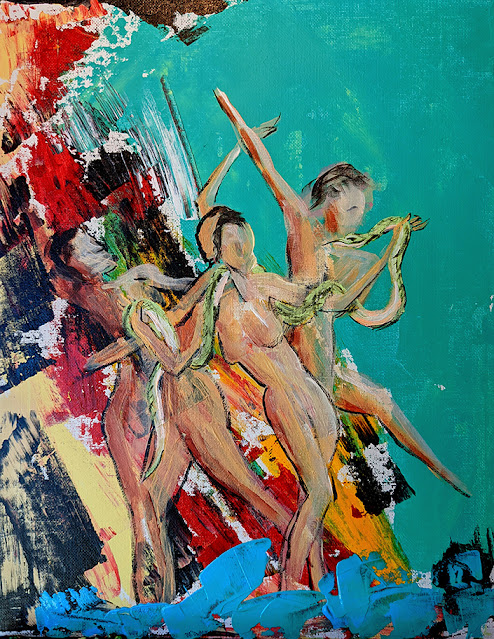"Eurynome, the Goddess of All Things, rose naked from Chaos, but found nothing substantial for her feet to rest upon, and therefore divided the sea from the sky, dancing lonely upon its waves. She danced towards the south, and the wind set in motion behind her seemed something new and apart with which to begin a work of creation. Wheeling about, she caught hold of this north wind, rubbed it between her hands, and behold! the great serpent Ophion." --Robert Graves, the Greek Myths
Eurynome original painting available through Saatchi Art. Prints, stickers, and other merch available in shop or through RedBubble or Fine Art America.
Eurynome is the Pelasgian Creator Goddess. The Pelasgians were inhabitants of the Aegean region before the arrival of proto-Greek speakers around 1200 BCE. They are mentioned numerous times by ancient Greek writers, and archaeological evidences suggests the Pelasgians were farming in Athens and surrounding areas as early 6000 BCE. Genetic and linguistic studies suggest the Pelasgians may have migrated from Asia Minor and spoken a pre-Indo European language (source).
Eurynome danced order out of chaos, calling our world into being. Like Jahi, on whom Eve is likely based, Eurynome created a great serpent to be her first consort. She produced the world egg, out of which tumbled "all things that exist, her children: sun, moon, planets, stars, the earth with its mountains and rivers, its trees, its herbs, and living creatures."
Later, her serpent Ophion became arrogant, claiming creation as his own. "Forthwith she bruised his head with her heel, kicked out his teeth, and banished him to the dark caves below the earth." Robert Graves links Ophion to "the serpent demiurge of Hebrew and Egyptian myth". I've painted the demiurge, Yaldabaoth, from Gnostic Christian texts, which developed under the same mythical influences.

Comments
Post a Comment